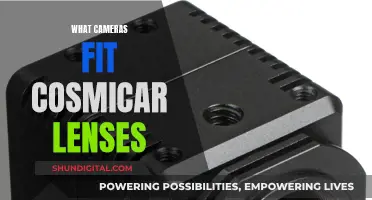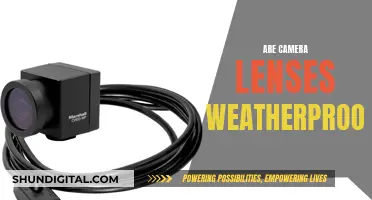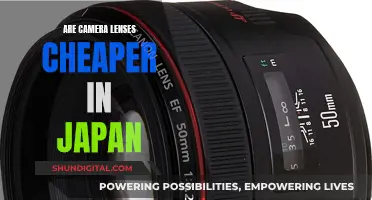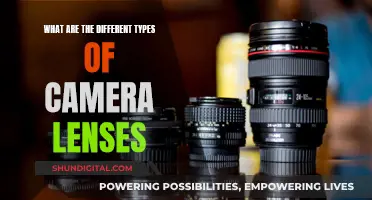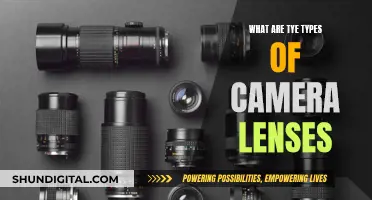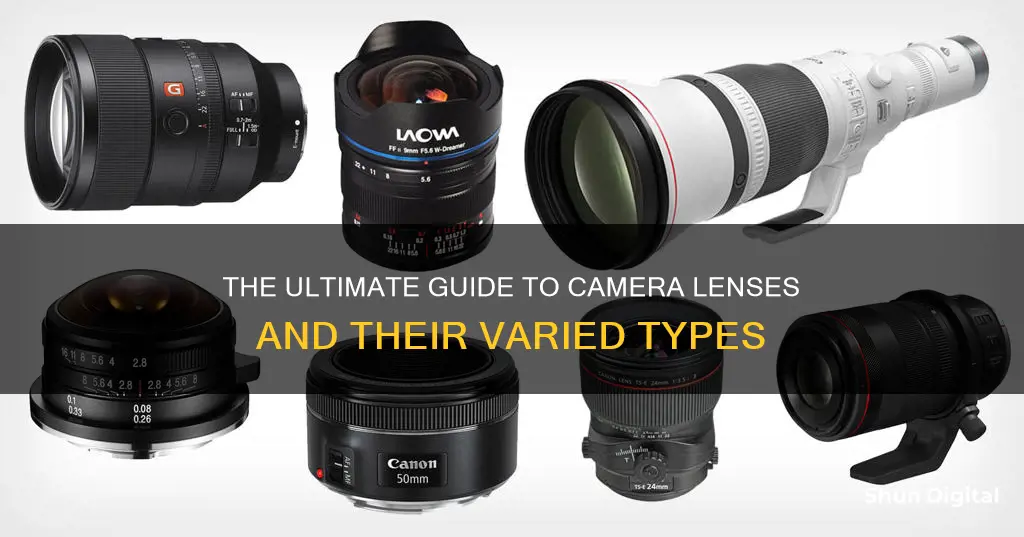
There are many different types of lenses for cameras, each with its own unique characteristics and uses. The lens is an essential component of a camera, as it is responsible for focusing light and creating an image. Different lenses offer different focal lengths, affecting how much of the scene is captured in the frame. Lenses can be divided into two main categories: prime and zoom. Prime lenses have a fixed focal length, while zoom lenses offer variable focal lengths. Within these categories, there are standard, wide-angle, and telephoto lenses. Standard lenses have a mid-range focal length, typically between 35mm and 70mm, offering a similar field of view to the human eye. Wide-angle lenses have shorter focal lengths, usually below 35mm, allowing for a broader scope. Telephoto lenses, on the other hand, have longer focal lengths, often above 60mm, and magnify distant subjects.
| Characteristics | Values |
|---|---|
| Type | Prime, Zoom, Standard, Wide-angle, Telephoto, Super-telephoto, Tilt-shift, Macro, Fisheye, Parfocal, Long-focus, Smartphone |
| Focal Length | 14mm-35mm (Wide-angle), 35mm-70mm (Standard), 70mm-200mm (Telephoto), 22mm-1mm (Fisheye), 55mm+ (Long-focus) |
| Aperture | Wider apertures allow more light and shallower depth of field; smaller apertures produce deeper depth of field |
| Weight | Super-telephoto lenses are big and heavy; prime lenses are lighter |
| Cost | Super-telephoto and tilt-shift lenses are very expensive |
| Image Quality | Prime lenses generally produce higher-quality images than zoom lenses |
| Versatility | Zoom lenses are more versatile than prime lenses |
| Use Cases | Wide-angle: landscapes, architecture; Telephoto: sports, wildlife; Macro: close-ups, portraits; Fisheye: fine art photography, extreme sports; Standard: street, travel, portrait, landscape |
What You'll Learn

Zoom lenses
If you are travelling light, you can find zoom lenses with even more range, such as an 18-270mm lens, allowing you to photograph both close-up and in the distance. This makes zoom lenses an excellent choice for photographers who need to shoot in a diverse range of scenarios or conditions.
While zoom lenses offer a lot of convenience and flexibility, there are some compromises to be aware of. The variable focal length comes at the cost of complexity, weight, dimensions, aperture, autofocus performance, and cost. For example, all zoom lenses suffer from at least a slight loss of image resolution at their maximum aperture, especially at the extremes of their focal length range. This effect is evident in the corners of the image when displayed in a large format or high resolution. The greater the range of focal length a zoom lens offers, the more exaggerated these compromises become.
Mirrorless Cameras: Capturing Why and How with Interchangeable Lenses
You may want to see also

Prime lenses
The main advantage of prime lenses is that they produce much higher-quality images than zoom lenses. This is because they have fewer moving parts, allowing for a wider maximum aperture, lighter weight, and smaller size. They are also often sharper and have lower levels of optical defects, such as chromatic aberrations.
The 50mm prime lens, also known as the "Nifty Fifty", is a popular choice among photographers as it is seen to be as close to the human eye as possible, making it perfect for portraits. A 35mm prime lens, on the other hand, is usually best for landscape photographers.
Lens Compatibility: EF-S Cameras and EF Lenses
You may want to see also

Telephoto lenses
A telephoto lens is a type of long-focus lens used in photography and cinematography. The physical length of the lens is shorter than its focal length. This is achieved by incorporating a special lens group, known as a telephoto group, which extends the light path to create a long-focus lens in a shorter overall design.
The simplest telephoto lens can be regarded as having two elements: one (on the object side) converging and another (on the image side) diverging. In practice, more than one element is used in each group to correct for aberrations. The combination of these two groups produces a lens assembly that is physically shorter than a long-focus lens producing the same image size.
RF Lenses: The Future of Mirrorless Photography?
You may want to see also

Wide-angle lenses
A wide-angle lens is generally considered to be one with a focal length of less than 35mm. This translates to an angle of view that is greater than 55 degrees across your photo's widest dimension. Focal lengths between 35mm and 24mm are considered standard wide angles, while those below 16mm are considered ultra-wide angles.
When using a wide-angle lens, it is important to get close to your subject to emphasise its size and create a dramatic perspective. They are particularly useful for street photography, travel photography, architecture and real estate photography, landscape photography, event photography, and photojournalism.
However, one must be cautious when photographing people with a wide-angle lens as it can distort their features and be unflattering. Additionally, when photographing interiors or enclosed spaces, be mindful of lens flare as the sun is more likely to enter the composition.
Cleaning Camera Lenses and Filters: A Step-by-Step Guide
You may want to see also

Macro lenses
A macro lens is a type of camera lens that allows you to focus extremely closely on a subject, making it appear larger in the viewfinder and in the final image. Macro lenses are defined by their ability to focus at very close range, with a minimum focus distance of just a few inches in some cases. This allows photographers to capture tiny details that would otherwise be invisible to the naked eye.
Unlike other camera lenses, macro lenses cannot be categorised solely by their focal length, which can range from 35mm to 200mm. Instead, macro lenses are defined by their ability to reproduce subjects at a 1:1 ratio, meaning that a subject will appear on the camera's sensor at the same size as it is in real life. Some lenses, such as the Canon MP-E 65mm 1-5x Macro, can even exceed this life-sized reproduction, offering even greater magnification.
Typical subjects for macro photography include insects, flowers, jewellery, coins, and other small objects. Macro lenses can also be used for portraits, creating a beautiful bokeh effect.
Some popular options for macro lenses include:
- Canon EF 100mm F/2.8L Macro IS USM
- Nikon AF-S VR Micro-Nikkor 105mm f/2.8G IF-ED
- Fujifilm FUJINON XF 80mm F/2.8 R LM OIS WR Macro
Understanding Camera Lenses: Numbers and Their Meanings
You may want to see also
Frequently asked questions
The two main types of camera lenses are zoom lenses and prime lenses. Zoom lenses have variable focal lengths, while prime lenses have a fixed focal length.
A standard lens has a mid-range focal length, typically between 35mm and 70mm. It provides a similar field of view to the human eye, making it a versatile choice for various photography genres, including street, travel, and portrait photography.
A telephoto lens has a focal length greater than 60mm and offers magnification for capturing distant subjects. It is commonly used in sports and wildlife photography, as well as for achieving a blurry background effect in portraits.
A wide-angle lens has a focal length shorter than 40mm, allowing you to capture more of the scene in a single frame. It is commonly used in landscape and architecture photography to capture expansive scenes or fit large subjects within the frame.


